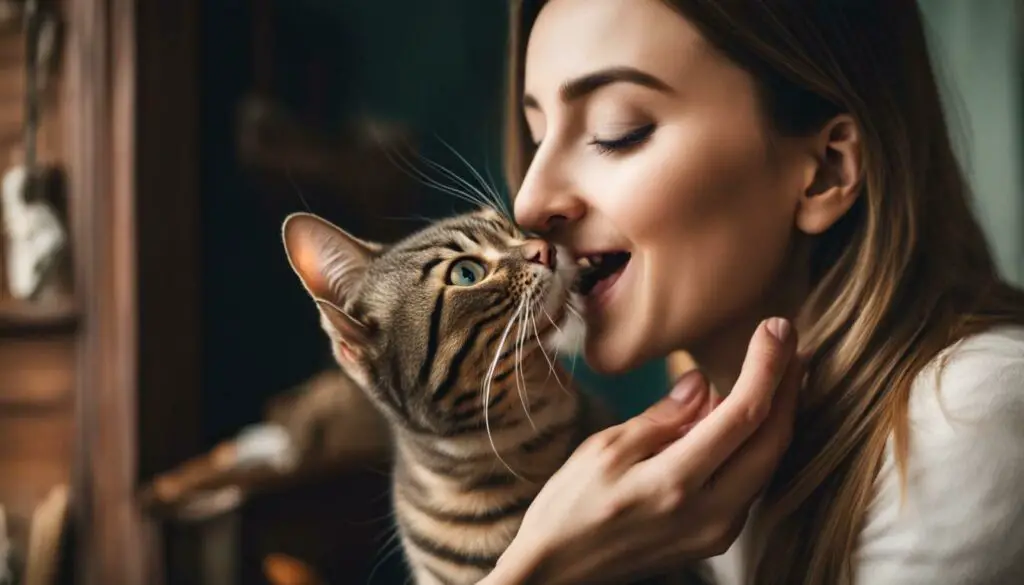Have you ever wondered why your cat shows affection by licking you, only to follow it up with a bite? Understanding the reasons behind this behavior is key to building a stronger bond with your feline companion. In this article, we will explore the various factors that contribute to cats licking and then biting their owners, and we will provide insights on how to decode and address these behaviors.
Key Takeaways:
- Cats may lick and bite their owners due to overstimulation, grooming behavior, lack of awareness of their biting strength, stress and anxiety, or affectionate playfulness.
- Recognizing the signs of overstimulation and preventing it can help avoid biting incidents.
- Redirecting your cat’s attention with toys and treats can deter biting behavior.
- Identifying and addressing the source of stress in your cat’s environment can help reduce biting.
- Establishing boundaries and differentiating between playful and aggressive biting is important for a harmonious relationship.
Understanding your cat’s behavior and responding appropriately will not only improve your relationship but also create a safe and enjoyable environment for both you and your feline companion. Let’s dive deeper into the world of cat behavior and find effective ways to address the licking and biting phenomenon.
Overstimulation: When too much is not a good thing
Cats have their limits when it comes to receiving physical affection, and overstimulation can often be the cause of their sudden change in behavior. While most cats enjoy being petted and cuddled, there is a threshold where their tolerance can be exceeded. When this happens, they may become agitated and resort to biting as a way to communicate their discomfort.
It’s crucial to pay attention to your cat’s body language and recognize the signs of overstimulation. Dilated pupils, twitching tail, flattened ears, or a sudden change in the way they interact with you can indicate that they’ve had enough. It’s important to respect their boundaries and give them space when they start showing these signs.
To prevent overstimulation and potential biting, it’s essential to establish a routine that includes both active playtime and quiet alone time. Engaging your cat in interactive play sessions with appropriate toys can help release their energy and prevent them from becoming overly stimulated. Additionally, providing them with designated spaces where they can retreat and relax can also be beneficial.
Remember, every cat is unique, and their tolerance for physical affection may vary. By paying attention to their cues, respecting their boundaries, and providing them with the right outlets for their energy, you can build a stronger bond with your feline companion and avoid the discomfort that overstimulation can bring.
Grooming Behavior: Licking as a form of care.
Cats use grooming not only to keep themselves clean but also as a way to bond with their owners. When a cat licks you, it is a sign of trust and affection. Grooming behavior is a natural instinct for cats, as they spend a significant amount of time grooming themselves and other cats in their social group.
However, sometimes this grooming behavior can lead to unintentional biting. Cats may start by licking and then transition to biting if they become overstimulated or if they are trying to remove a knot or tangle in your hair or clothing. It’s important to understand that cats have different thresholds for stimulation, and what may be enjoyable petting for one cat can be overwhelming for another.
To prevent biting during grooming sessions, it’s crucial to pay attention to your cat’s body language. If you notice signs of overstimulation, such as flattened ears, twitching tail, or increased vocalization, it’s best to give your cat a break and allow them to calm down. You can also redirect their attention by offering them a toy or treat to distract them from biting.
| Signs of overstimulation: | How to respond: |
|---|---|
| Flattened ears | Stop petting, give your cat space. |
| Twitching tail | Cease petting and observe your cat for other signs of discomfort. |
| Increased vocalization | Stop petting and allow your cat to calm down. |
Grooming behavior is an important way for cats to communicate with their owners and establish a sense of familiarity and trust. By understanding the reasons behind licking and biting behavior, you can strengthen your bond with your feline companion and ensure a harmonious relationship based on love and understanding.
Unaware of Their Strength: Nipping without realizing it hurts
Cats may be unaware of their own strength and unintentionally bite their owners during play or grooming sessions. What may seem like an innocent nibble can actually cause pain or discomfort. It’s important for cat owners to recognize this behavior and take steps to prevent it.
During playtime, cats can become overly excited and may not understand that their biting can hurt humans. They may see it as a form of play or a way to engage with their owners. However, it’s essential to establish boundaries and redirect their attention to appropriate toys or treats.
Grooming behavior can also lead to unintentional biting. Cats use their tongues to groom themselves and their owners, and sometimes their bites can be a result of this grooming process. They may not realize that their bites can cause discomfort, especially when they are trying to remove a mat or tangle from their owner’s hair.
| Tip | Solution |
|---|---|
| Provide interactive toys | Engaging your cat with interactive toys can redirect their attention from biting to appropriate play behavior. |
| Offer treats during grooming | Using treats during grooming sessions can help distract your cat and prevent them from biting unintentionally. |
| Establish playtime boundaries | Set clear boundaries during playtime and avoid encouraging aggressive behavior. Use positive reinforcement to reward your cat for gentle play. |
Understanding that cats may not be aware of their strength when they bite is crucial for cat owners. By redirecting their behavior and providing appropriate outlets for their energy, you can help prevent unintentional biting and strengthen the bond with your furry friend.
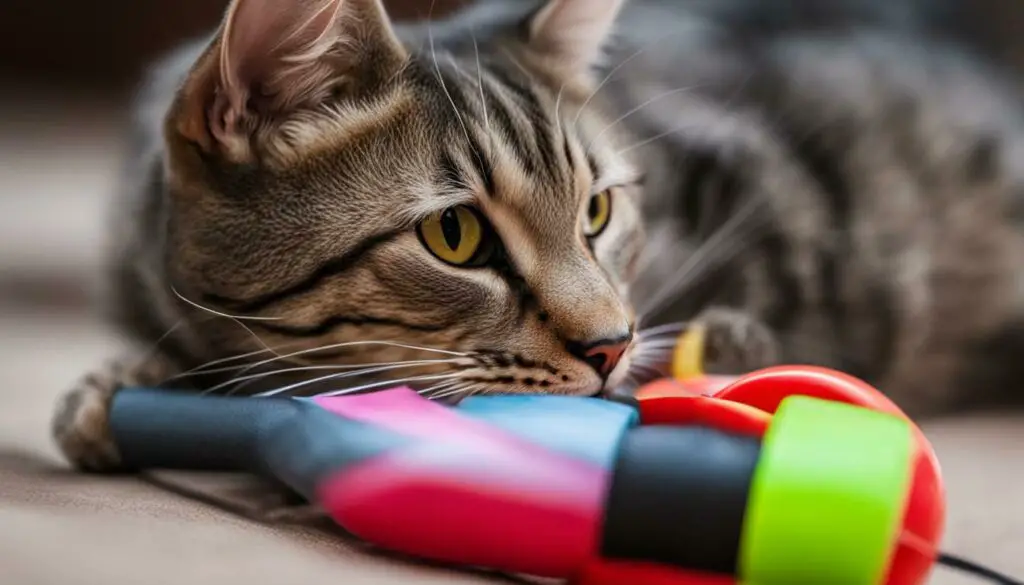
Stress and Anxiety: When biting becomes a coping mechanism
Just like humans, cats can experience stress and anxiety, often resulting in unwanted behavior such as biting. It’s important for cat owners to recognize the signs of stress in their feline companions and address the underlying causes to prevent biting.
Stressors for cats can be diverse, including changes in environment, loud noises, introduction of new pets, or even separation anxiety. When cats feel overwhelmed or threatened, they may resort to biting as a coping mechanism.
To help reduce stress and prevent biting, it’s essential to create a calm and secure environment for your cat. Providing a designated safe space, with hiding spots and comfortable bedding, can help alleviate anxiety. Additionally, engaging in regular play sessions and providing environmental enrichment, such as interactive toys and scratching posts, can help divert their attention and release pent-up energy.
It’s also advisable to consult with a veterinarian or animal behaviorist who can provide guidance and recommend appropriate strategies to manage your cat’s stress and anxiety. They may suggest behavioral modification techniques, natural supplements, or in some cases, prescription medications to help your cat feel more at ease.
| Signs of Stress in Cats | Suggestions to Reduce Stress |
|---|---|
|
|
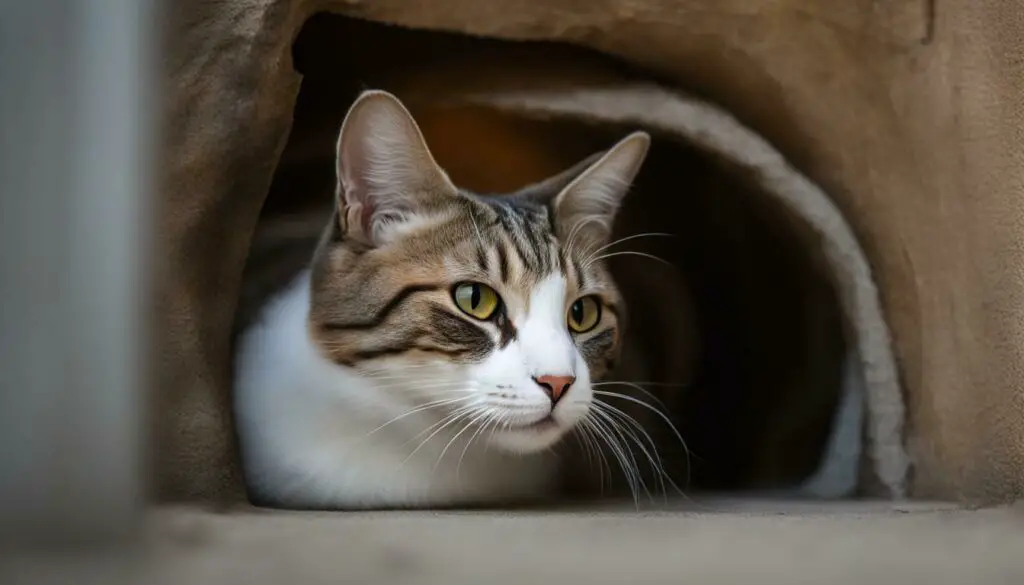
Understanding and addressing the root causes of stress and anxiety in cats can help prevent biting behavior and promote a harmonious relationship between you and your furry friend.” – Dr. Emily Thompson, Veterinarian
Affectionate Playfulness: Love that sometimes hurts
Cats may show their affection through playful nibbles, but it’s important to redirect this behavior to ensure a safe and enjoyable interaction. Playful biting is a common behavior in cats, especially when they are young. It’s their way of showing love and establishing a playful connection with their owners.
To redirect this behavior, provide your cat with interactive toys that they can bite and wrestle with, such as feather wands or puzzle toys with treats hidden inside. Engaging in regular play sessions with your cat using these toys can help fulfill their natural hunting instincts and redirect their biting behavior in a positive way.
Remember to establish boundaries during playtime. If your cat becomes too rough or starts to bite hard, gently withdraw your hand or the toy and redirect their attention to a more appropriate plaything. This will help teach them that biting is not acceptable and promote a safer and more enjoyable interaction.
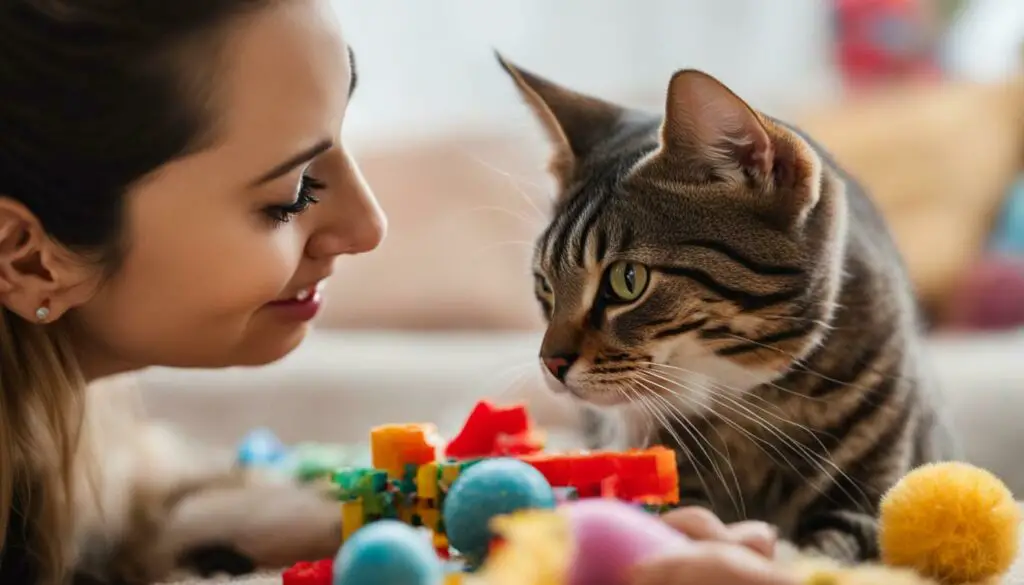
In addition to redirecting biting behavior, it’s important to reward your cat when they show affection in a non-aggressive manner. When your cat licks you or nuzzles against you without biting, offer them verbal praise, a gentle stroke, or a small treat. This positive reinforcement will help reinforce the desired behavior and strengthen the bond between you and your feline friend.
Understanding and redirecting your cat’s affectionate playfulness can contribute to a harmonious relationship and ensure that interactions with your cat remain enjoyable and safe for both of you.
| Section 6 Summary |
|---|
| Cats may show their affection through playful nibbles, but redirecting this behavior is essential for a safe and enjoyable interaction. Provide interactive toys to redirect their biting behavior in a positive way. Establish boundaries during playtime and redirect their attention when biting becomes too rough. Reward your cat for non-aggressive affectionate behavior to reinforce positive interactions. Understanding and redirecting affectionate playfulness promotes a harmonious relationship. |
Redirecting Behavior: Toys and treats as a distraction
Redirecting your cat’s behavior with toys and treats can help prevent them from transitioning from licking to biting. Providing appropriate toys and treats can be an effective way to redirect their attention and engage them in more appropriate behaviors.
Introducing interactive toys, such as feather teasers or puzzle toys, can help stimulate your cat mentally and physically, providing a healthy outlet for their energy. These toys help redirect their focus onto play and exploration, reducing the likelihood of them resorting to biting.
Treats can also be used as a positive reinforcement tool when your cat displays desirable behavior. Rewarding them with treats for gentle interactions and using clicker training can encourage them to associate play and affection with positive experiences, reinforcing good behavior and reducing the likelihood of biting incidents.
| Tips for Redirecting Your Cat’s Behavior |
|---|
| 1. Offer a variety of toys to keep your cat engaged and interested. |
| 2. Rotate toys regularly to prevent boredom. |
| 3. Use treat-dispensing toys to provide mental stimulation. |
| 4. Ensure toys are safe and appropriate for your cat’s size and age. |
Redirecting your cat’s behavior with toys and treats not only helps prevent them from transitioning from licking to biting, but it also enhances their overall well-being by providing mental and physical stimulation. By employing these techniques, you can create a positive and enjoyable environment for both you and your feline companion.

Establishing Boundaries: Setting limitations for both of you
Creating clear boundaries and enforcing them gently is crucial in preventing your cat from biting you. Cats have different personalities and may exhibit biting behavior for various reasons, but it’s important to establish guidelines to ensure a safe and enjoyable interaction. Here are some tips to help you set limitations with your feline companion:
- Recognize your cat’s warning signs: Before a bite occurs, cats typically display certain body language cues that indicate they are feeling overwhelmed or uncomfortable. These may include flattened ears, a twitching tail, dilated pupils, or a tense body posture. By learning to recognize these signs, you can intervene before a bite happens.
- Provide your cat with an alternative outlet: Cats may bite when they are bored or seeking attention. By providing them with appropriate toys, scratching posts, and interactive play sessions, you can redirect their energy towards more suitable activities.
- Use positive reinforcement: Reward your cat for good behavior and avoid punishing them physically or shouting. Positive reinforcement techniques, such as treats or praise, can help reinforce desired behaviors and strengthen your bond with your cat.
Remember, consistency is key when establishing boundaries with your cat. It may take time for them to adjust to the new rules, but with patience and gentle guidance, you can effectively discourage biting behavior.
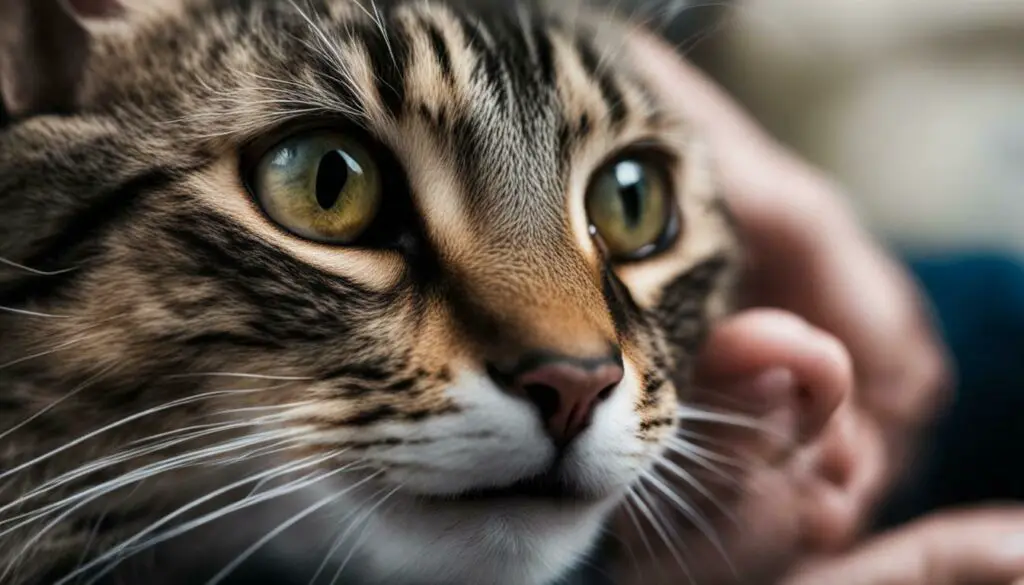
Table 1: Common Signs of Feline Discomfort
| Body Language Cues | What it Indicates |
|---|---|
| Flattened ears | Sign of fear or anxiety |
| Twitching tail | Agitation or annoyance |
| Dilated pupils | Heightened arousal or stress |
| Tense body posture | Sign of aggression or discomfort |
“Understanding your cat’s body language is key to preventing biting. By paying attention to their signals, you can ensure a safer and more harmonious relationship.” – Dr. Jane Thompson, Feline Behavior Specialist
Identifying Stressors: Addressing the root cause.
Pinpointing the root cause of your cat’s stress can help you find ways to address their biting behavior. Cats are sensitive creatures, and various factors can contribute to their stress levels. By understanding and addressing these stressors, you can create a more peaceful and harmonious environment for your feline friend.
One common source of stress for cats is changes in their surroundings. Moving to a new home or rearranging furniture can disrupt their sense of familiarity and security. Additionally, loud noises, such as construction work or thunderstorms, can cause anxiety in cats. In these situations, providing a quiet and safe space for your cat to retreat to can help alleviate their stress.
Another common stressor is social interaction or lack thereof. Cats are territorial animals and may feel threatened by the presence of other pets or unfamiliar people in their environment. On the other hand, isolation and lack of socialization can also lead to stress. Ensuring that your cat has a balance of social interaction and alone time can help reduce their stress levels.
Environmental factors, such as a lack of stimulation or enrichment, can also contribute to a cat’s stress. Cats are naturally curious and need mental and physical stimulation. Providing toys, scratching posts, and interactive play sessions can help alleviate boredom and prevent stress-related behaviors like biting.

Table 1: Common Stressors for Cats
| Stressor | Impact on Cats |
|---|---|
| Changes in environment | Disruption of familiarity and security |
| Loud noises | Causes anxiety and fear |
| Presence of other pets or unfamiliar people | Feelings of threat and territoriality |
| Isolation and lack of socialization | Feelings of loneliness and stress |
| Lack of stimulation or enrichment | Boredom and pent-up energy |
Addressing these stressors requires a patient and proactive approach. By creating a calm and secure environment, providing appropriate socialization, and ensuring mental and physical stimulation, you can help your cat feel more relaxed and content. If the biting behavior persists despite your efforts, seeking professional help from a veterinarian or animal behaviorist is recommended to explore further solutions.
Professional Help: When to seek assistance
If your cat’s biting behavior persists despite your efforts, it may be necessary to consult with a professional who specializes in feline behavior. Seeking professional help can provide valuable insight and guidance in understanding and managing your cat’s behavior problems.
When determining if it’s time to seek professional assistance, consider the severity and frequency of the biting incidents. If the biting is aggressive, causing injury, or escalating over time, it’s important to take action promptly. A professional can help assess the underlying causes and develop a customized behavior modification plan for your cat.
Additionally, if you have tried various strategies and techniques without success, a professional can offer new approaches and techniques that may be more effective. They can also provide guidance on how to establish a safe and nurturing environment for your cat, minimizing stress and anxiety triggers.
Consulting with a professional who specializes in feline behavior can provide valuable insights and guidance in understanding and managing cat biting behavior.
Remember, seeking professional help is not a sign of failure as a cat owner. It’s a responsible step to ensure the well-being of both you and your cat. Professionals have the knowledge and experience to address complex behavior issues, providing you with the support and resources needed to foster a harmonious relationship with your feline companion.
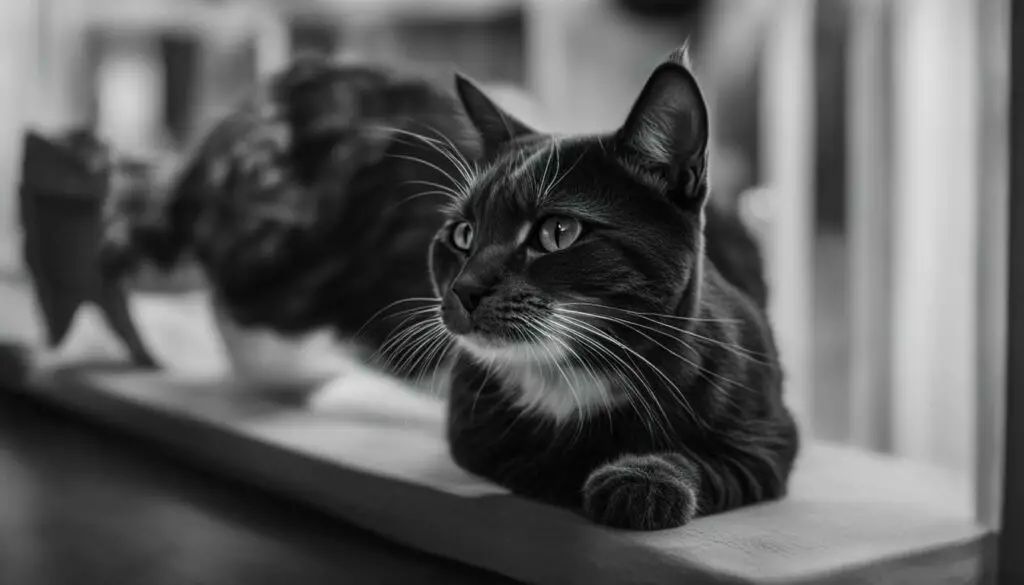
| Signs That May Indicate the Need for Professional Help |
|---|
| Consistent biting that causes injury |
| Biting that escalates in intensity or frequency |
| Signs of aggression, such as hissing or growling |
| Biting that occurs without warning or trigger |
| Lack of improvement despite trying different strategies |
| Other concerning behaviors, such as excessive fear or avoidance |
Summary:
If your cat’s biting behavior persists despite your efforts, it may be necessary to seek professional help. A professional who specializes in feline behavior can assess the underlying causes, develop a behavior modification plan, and provide guidance on creating a safe and nurturing environment for your cat. Remember, seeking professional assistance is not a sign of failure but a responsible step towards resolving behavior problems and fostering a harmonious relationship with your feline companion.
Promoting Positive Interaction: Strengthening your bond.
By understanding your cat’s behavior and responding appropriately, you can create a nurturing environment that enhances your bond with them. Building a strong connection with your feline companion requires promoting positive interactions and establishing trust. Here are some tips to help strengthen your bond:
- Engage in interactive play: Playtime is crucial for your cat’s physical and mental stimulation. Use interactive toys, such as feather wands or laser pointers, to engage them in play. This not only provides exercise but also strengthens your bond as you spend quality time together.
- Provide enriching environments: Create a stimulating environment for your cat by offering scratching posts, climbing trees, and puzzle toys. This allows them to engage in natural behaviors and reduces boredom, which can lead to unwanted behaviors like biting.
- Use positive reinforcement: Reward your cat for good behavior with treats, praise, and gentle strokes. Positive reinforcement helps them associate your presence with positive experiences, reinforcing the bond between you.
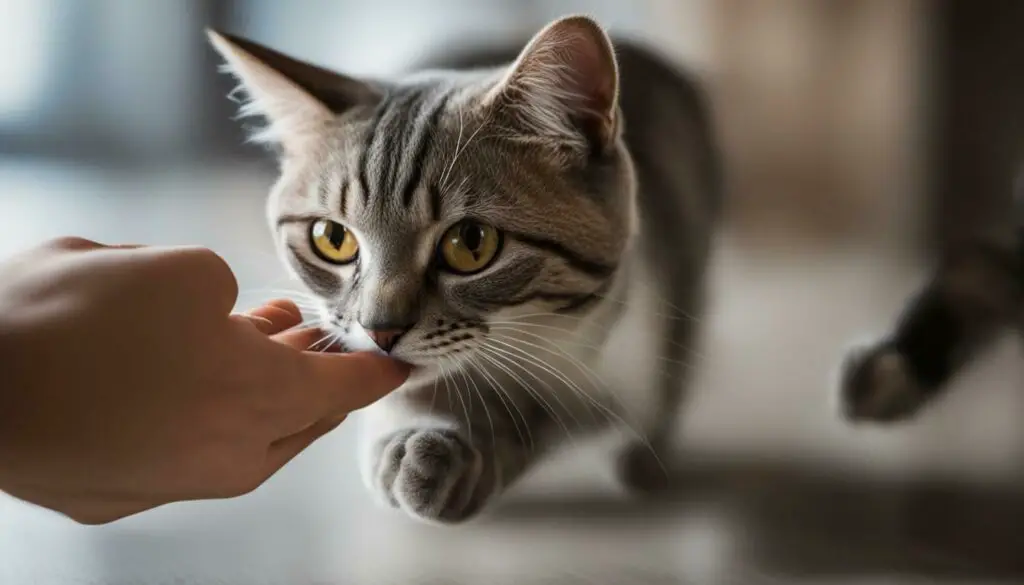
In addition to these tips, it’s important to pay attention to your cat’s body language. Watch for signs of stress or overstimulation, such as flattened ears, dilated pupils, or a flicking tail. If you notice these signs, give your cat space and allow them to calm down. Respect their boundaries and avoid overwhelming them with excessive attention.
Safety first: Handling aggressive behavior
If your cat exhibits aggressive behavior like biting, it’s crucial to handle the situation safely. Avoid punishment or harsh reprimands, as this can escalate the aggression. Instead, calmly remove yourself from the situation and give your cat time to calm down.
“Building a strong connection with your feline companion requires promoting positive interactions and establishing trust.”
Consulting with a veterinarian or an animal behaviorist can also be helpful in addressing aggressive behavior. They can provide tailored advice and guidance based on your cat’s individual needs.
| Signs of stress in cats | Ways to alleviate stress |
|---|---|
| Excessive grooming | Provide hiding spots or safe spaces |
| Loss of appetite | Stick to a consistent feeding routine |
| Increased vocalization | Create a peaceful environment with calming pheromone diffusers |
Remember, each cat is unique, and understanding their behavior requires patience and observation. By promoting positive interactions, addressing their needs, and seeking professional help when necessary, you can create a loving and harmonious relationship with your feline friend.
Patience and Consistency: Keys to Success
Addressing biting behavior in your cat requires a patient and consistent approach to achieve long-term success. Cats may lick and then bite their owners for various reasons, but understanding these behaviors is crucial in order to respond appropriately. One of the common reasons for biting is overstimulation. Excessive petting can make a cat uncomfortable, so it’s important to pay attention to their body language and recognize when they’ve had enough. By playing with your cat and avoiding overstimulation, you can prevent them from resorting to biting.
Grooming behavior is another reason why cats may lick their owners and then bite. Cats see grooming as a form of social interaction, but sometimes they may not realize that their biting can cause pain. Redirecting their attention with toys or treats can help prevent them from unintentionally hurting you.
Stress can also lead to biting behavior in cats. It’s essential to identify and address the root cause of their stress, whether it’s environmental changes, lack of stimulation, or social conflicts. By creating a calm and stress-free environment for your cat and providing them with appropriate outlets for their energy, you can help alleviate their anxiety and reduce biting incidents.
Biting can also be a sign of affection or playfulness in cats. While it’s important to encourage positive interactions, it’s equally crucial to establish boundaries. Redirecting their playful behavior towards appropriate toys and establishing consistent rules will help prevent them from using biting as a means of play. Remember, building a strong bond with your cat requires patience and consistency, as well as understanding their individual needs and behaviors.
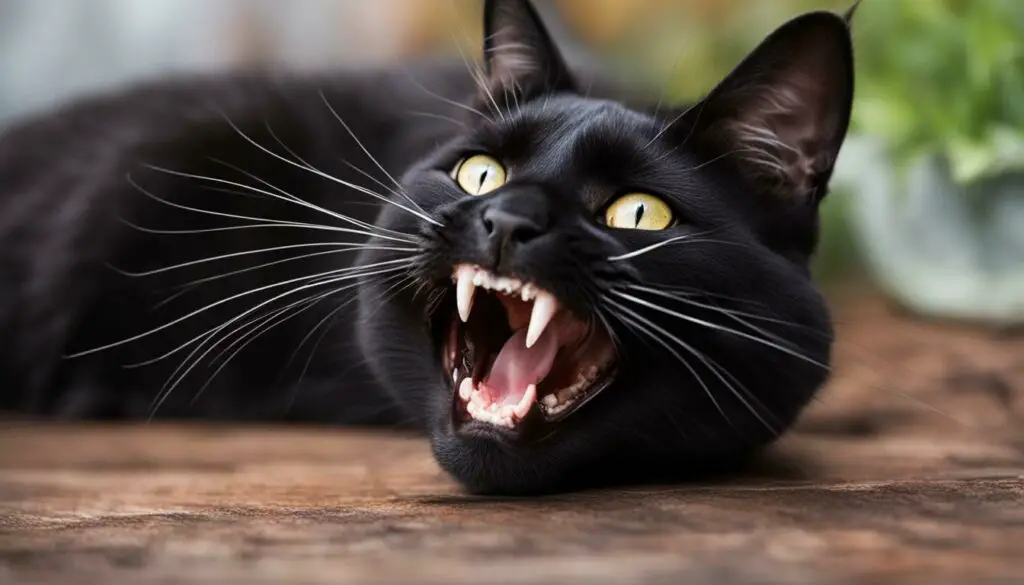
Summary:
- Address biting behavior in your cat with a patient and consistent approach.
- Avoid overstimulation and recognize your cat’s body language to prevent biting.
- Redirect their attention with toys or treats and establish boundaries.
- Identify and address the root cause of stress to reduce biting incidents.
- Encourage positive interactions while setting limits with consistent rules.
| Reason for Biting | Prevention |
|---|---|
| Overstimulation | Pay attention to your cat’s body language and avoid excessive petting. |
| Grooming Behavior | Redirect their attention with toys or treats to prevent unintentional biting. |
| Stress and Anxiety | Create a calm environment and address the source of stress to reduce biting incidents. |
| Affectionate Playfulness | Encourage positive interactions with appropriate toys and establish boundaries. |
Safe and Enjoyable Interaction: Tips for harmonious moments
Creating an environment that encourages safe and enjoyable interactions with your cat is key to preventing biting incidents. By understanding your cat’s behavior and following a few simple guidelines, you can foster a harmonious relationship based on trust and understanding.
Firstly, it’s important to provide your cat with appropriate outlets for their natural behaviors. Engaging in interactive play sessions using toys that encourage hunting and pouncing can help satisfy your cat’s instinctual needs. This not only helps prevent boredom but also reduces the likelihood of them redirecting their playfulness onto you.
Additionally, setting clear boundaries and establishing a routine can promote positive interactions. Cats thrive on consistency, so maintaining a schedule for feeding, playtime, and rest can help reduce their stress levels. This, in turn, can minimize the chances of aggressive behavior, including biting.
| Tip | Description |
|---|---|
| Provide scratching posts and toys | Cats have a natural urge to scratch and play. Offering appropriate outlets for these behaviors can prevent them from turning to biting. |
| Observe body language | Keep an eye on your cat’s body language to identify signs of discomfort or overstimulation. This can help you adjust your interactions accordingly to avoid bites. |
| Schedule regular playtime | Dedicating time each day to play with your cat helps them release pent-up energy and reduces the likelihood of aggressive behavior. |
Remember, every cat is unique, and what works for one may not work for another. It’s essential to observe and understand your cat’s individual needs and preferences. By providing a safe and stimulating environment and respecting their boundaries, you can build a strong and loving bond with your feline companion.
Understanding Your Cat’s Body Language: Reading the signs
Recognizing and understanding your cat’s body language is essential in maintaining a harmonious relationship and preventing biting incidents. Cats communicate through their behaviors and body postures, and being able to interpret these signals can help you respond appropriately to your feline friend’s needs.
One common body language signal that cats display is the position of their ears. When a cat’s ears are relaxed and facing forward, it indicates that they are calm and content. However, if their ears flatten backwards or sideways, it may be a sign of fear, anxiety, or aggression. In such cases, it’s best to give your cat some space and avoid any sudden movements that might trigger a defensive response.
The tail is another important indicator of a cat’s mood. A relaxed tail held low or gently swaying from side to side suggests that your cat is feeling calm and comfortable. Conversely, a puffed-up tail or one that is lashing back and forth rapidly may indicate heightened agitation or anxiety. If you notice these signs, it’s important to create a calm environment and allow your cat to retreat to a safe, quiet space.
| Position | Meaning |
|---|---|
| Relaxed, forward | Calm and content |
| Flatten backwards or sideways | Fear, anxiety, or aggression |
| Low and gently swaying | Calm and comfortable |
| Puffed-up or lashing back and forth rapidly | Agitation or anxiety |
Understanding your cat’s body language can help you anticipate their behavior and prevent biting incidents. By observing their ears, tail, and other physical cues, you can better respond to their needs and provide a safe and nurturing environment for them.
Other body language signals to pay attention to include:
- Purring: Usually a sign of contentment, but can also indicate anxiety or pain depending on the context.
- Slow blinking: A relaxed and trusting gesture, often used as a form of communication between cats and their owners.
- Bristled fur: Indicates fear or aggression. It is important to give your cat space and avoid approaching them when their fur is standing on end.
- Body posture: A cat that is crouched low to the ground with dilated pupils may be preparing to attack. Conversely, a cat that is lying on its back with its belly exposed is typically displaying a sign of trust and relaxation.
By familiarizing yourself with these body language signals and putting them into context with your cat’s overall behavior, you can better understand their needs and emotions. This understanding will allow you to respond appropriately, preventing potential biting incidents and maintaining a harmonious relationship with your feline companion.
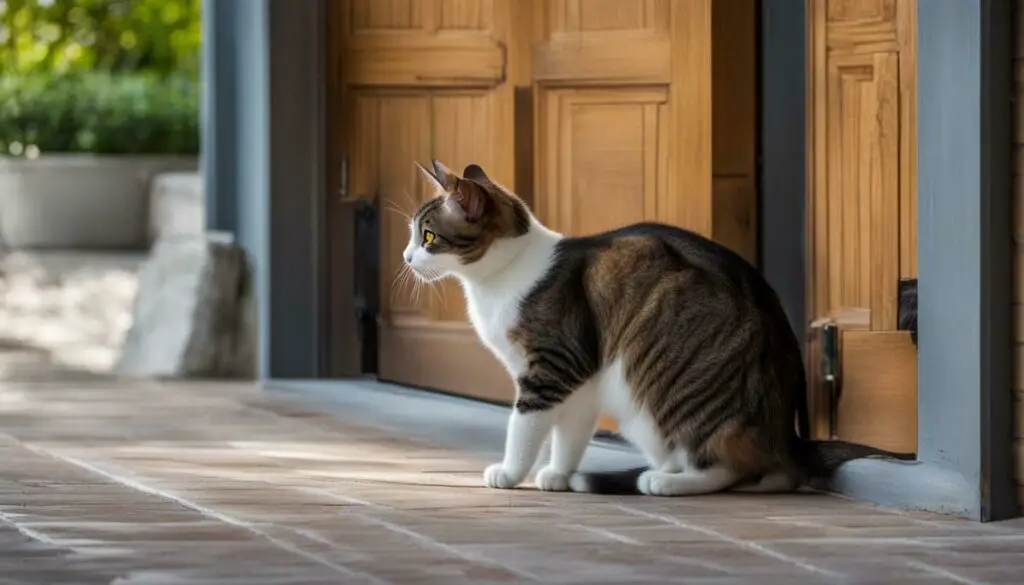
Understanding your cat’s body language is key to deciphering their behavior and maintaining a positive relationship. By being attentive to their signals and providing a safe and comfortable environment, you can foster trust and prevent biting incidents. Remember, each cat is unique, so take the time to observe and learn your cat’s individual body language cues.
Conclusion
By understanding why cats lick and then bite, and implementing appropriate strategies, you can foster a deeper and more fulfilling bond with your furry friend.
Cats may lick and then bite their owners for various reasons. One common cause is overstimulation, where excessive petting becomes uncomfortable for the cat. To prevent this, it’s important to pay attention to their body language and give them breaks during playtime or cuddling sessions.
Another reason for licking and biting behavior is grooming. Cats see grooming as an important part of their social interaction, and they may extend this behavior to their owners. However, they may not realize that their biting can cause pain. To redirect their attention, provide appropriate toys or treats that they can focus on instead.
Stress can also manifest in biting behavior. If your cat is exhibiting this behavior, it’s important to identify and address the source of their stress. Providing a calm and safe environment, as well as engaging in activities that promote relaxation, can help alleviate their anxiety.
Sometimes, biting can also be a sign of affection or playfulness. While it’s important to appreciate their love, it’s equally crucial to redirect this behavior and establish boundaries. Encourage interactive play with appropriate toys and discourage them from using your hands or feet as playthings.
By understanding these reasons for biting and responding appropriately, you can build a stronger bond with your feline companion. Remember, patience and consistency are key, and always prioritize your cat’s well-being and happiness.
FAQ
Why do cats lick their owners and then bite?
Cats may lick and then bite their owners for various reasons, including overstimulation, grooming behavior, unawareness of their strength, stress and anxiety, affectionate playfulness, and establishing boundaries. Understanding these reasons can help cat owners better respond to their pet’s behavior.
How can I prevent my cat from biting due to overstimulation?
Recognizing signs of overstimulation, such as tail flicking or tense body language, can help you avoid reaching the point where your cat feels uncomfortable and reacts by biting. Taking breaks during petting sessions, playing with interactive toys, and providing a calm environment can help prevent overstimulation.
Why do cats groom their owners and sometimes end up biting?
Cats see grooming as a form of social interaction and may groom their owners as a sign of affection. However, they may not realize that their biting can cause pain. Distracting your cat with toys or treats can redirect their attention and prevent unintentional bites.
How can I redirect my cat’s attention if they tend to bite?
Offering toys or treats during moments when your cat is likely to bite can help redirect their attention and prevent them from engaging in biting behavior. Interactive toys or puzzles can also provide mental stimulation and be a great alternative to biting.
What should I do if my cat’s biting is caused by stress?
Identifying and addressing the source of your cat’s stress is crucial. This may involve creating a calm and safe environment, providing hiding spaces or vertical territory, and using pheromone products to help alleviate anxiety. In more severe cases, it may be necessary to consult with a veterinarian or animal behaviorist for further assistance.
Is biting a sign of affection or playfulness in cats?
Yes, biting can sometimes be a sign of affection or playfulness in cats. However, it’s important to redirect this behavior and establish boundaries. Encourage appropriate play with toys and discourage biting by using positive reinforcement and providing alternative outlets for their energy.
How can I establish boundaries with my cat to prevent biting?
Effective communication and training techniques can help you establish boundaries with your cat. Use positive reinforcement to reward desired behaviors and discourage biting. Avoid rough play and teach your cat what is acceptable through consistent training and redirection.
How can I identify stressors that trigger my cat’s biting behavior?
Pay attention to your cat’s environment, daily routine, and interactions to identify potential stressors. Common stressors may include changes in the home, introduction of new pets, loud noises, or medical conditions. Addressing these stressors can help reduce your cat’s biting behavior.
When should I seek professional help for my cat’s biting behavior?
If your cat’s biting behavior is severe, persistent, or causing harm, it’s advisable to seek professional help. A veterinarian or animal behaviorist can assess the situation, provide further guidance, and develop a personalized plan to address the issue.
How can I strengthen my bond with my cat and promote positive interaction?
Building a strong bond with your cat involves promoting positive interactions. Spend quality time engaging in activities your cat enjoys, such as interactive play sessions or gentle grooming. Use positive reinforcement, treats, and praise to reinforce desired behavior and create a positive association.
What qualities do I need to effectively address my cat’s biting behavior?
Patience and consistency are key when dealing with a cat’s biting behavior. It may take time to modify their behavior, so remain patient and avoid reacting with aggression or punishment. Consistently reinforce appropriate behavior through positive reinforcement, redirection, and clear communication.
How can I ensure safe and enjoyable interaction with my cat?
To ensure safe and enjoyable interactions with your cat, avoid rough play that may encourage biting behavior. Provide appropriate toys, scratching posts, and interactive play sessions. Additionally, always approach your cat calmly and respect their boundaries.
How can I interpret my cat’s body language to prevent biting?
Learning to interpret your cat’s body language can help you anticipate their behavior and prevent biting. Watch for signs such as flattened ears, tail flicking, or dilated pupils, which may indicate that your cat is feeling anxious or uncomfortable. Adjust your interaction accordingly to avoid triggering biting behavior.
Source Links
- https://cardboardcathomes.com/blogs/info/why-does-my-cat-lick-and-then-bite-me
- https://www.cats.org.uk/cats-blog/why-does-my-cat-bite-me
- https://cats.com/why-does-my-cat-lick-me-then-bite-me

